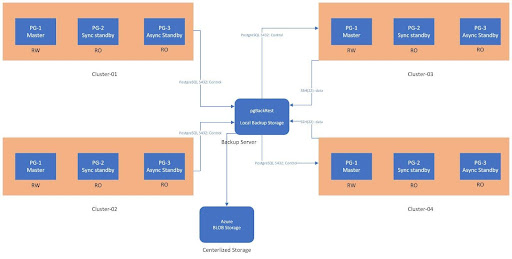


In the expansive realm of databases, Ashnik unfolds the pivotal sequel to its customer-centric journey, marked by technical prowess and adaptability. Part 2 of this series delves into the challenges faced in Backup, Recovery, and Monitoring, showcasing the strategic integration of open-source solutions to address these challenges head-on.
Table of Contents
The Landscape: Challenges in Backup, Recovery, and Monitoring
Building upon the success of Part 1, Ashnik acknowledges that a new set of challenges emerged in the domains of Backup, Recovery, and Monitoring. The landscape demanded resilient data strategies, robust recovery protocols, and real-time insights into system performance.
Backup and Recovery setup Architecture

Backup Strategies: Ensuring Data Resilience
In response to the evolving database needs, Ashnik meticulously explored comprehensive backup strategies. The emphasis was on safeguarding data integrity and ensuring swift recovery. The journey involved analyzing data structures, dependencies, and defining recovery point objectives to tailor backup solutions that align with the customer’s operational rhythm.
Recovery Protocols: Navigating Downtime Challenges
Downtime remains a critical concern, prompting Ashnik to craft recovery protocols that minimize disruptions. From point-in-time recovery harnessing PostgreSQL’s transaction log to standby servers poised for seamless takeover during primary system failures, each protocol was designed with a singular focus – ensuring uninterrupted operations.
Monitoring: Real-time Visibility for Proactive Management
Proactivity in database management is indispensable, and Ashnik recognized this by adopting advanced monitoring tools. The quest for real-time visibility into system performance, query efficiency, and resource utilization became a strategic endeavor. Open-source monitoring solutions were embraced to empower the customer with insights that transcend mere data observation.
Monitoring Tool Setup Architecture

Technical Examples and Statistics: Unveiling the Impact
Just as in Part 1, Ashnik continues its commitment to transparency by presenting technical examples and statistics. The tangible impact of the implemented strategies is laid bare through reduced downtime, expedited data recovery, and heightened system responsiveness. These statistics not only showcase technical proficiency but also act as a transparent representation of results achieved through a customer-centric lens.
Expected RTO/RPO and Real-world Challenges
a. Anticipating Recovery Challenges
Incorporating a critical element into the discussion, Ashnik provides insights into the Expected RTO (Recovery Time Objective) and Expected RPO (Recovery Point Objective). The anticipated values are set at less than or equal to 30 minutes with a buffer for RTO and less than or equal to 5 minutes for RPO, with an additional buffer. However, it is duly noted that these values may extend due to factors such as unexpected issues, network speed, and SME (Subject Matter Expert) execution speed and familiarity with the setup.
b. Navigating the Real-world Challenges
While the blog mentions factors such as unexpected issues, network speed, and SME execution speed, let’s delve deeper into these challenges. For instance, unexpected issues could range from unforeseen technical glitches to unexpected spikes in user activity. Network speed might vary based on geographical locations, impacting data transfer rates, and SME execution speed could be influenced by the complexity of the setup and the familiarity of the expert with the specific database environment.
Customer-Centric Approach: Beyond Technical Excellence
The customer-centric ethos that defined the first part seamlessly transitions into the realm of backup, recovery, and monitoring. Ashnik’s endeavor is not just about technical excellence; it’s about ensuring that every implemented strategy aligns with the customer’s operational needs. This fusion of technical prowess with a deep understanding of the customer’s ecosystem underscores the commitment to harmonizing technology with operational efficiency.
Conclusion: The Continuum of Transformation
As we conclude Part 2 of this customer-centric journey, it becomes evident that the transformation embarked upon by Ashnik extends beyond mere database management. It’s a continuum, a dynamic adaptation to the ever-evolving landscape of technology and customer needs. Stay tuned for further insights, technical revelations, and statistical revelations as the journey unfolds in the subsequent parts of this transformative series. The future of PostgreSQL database management is not just a story of software evolution; it’s a saga of resilience, responsiveness, and relentless commitment to customer success.
Ashnik’s journey in database management exemplifies resilience and adaptability in technology and customer engagement. For continued insights and updates, stay connected as we explore this evolving narrative in future installments. Reach out to us to be a part of this transformative experience.





